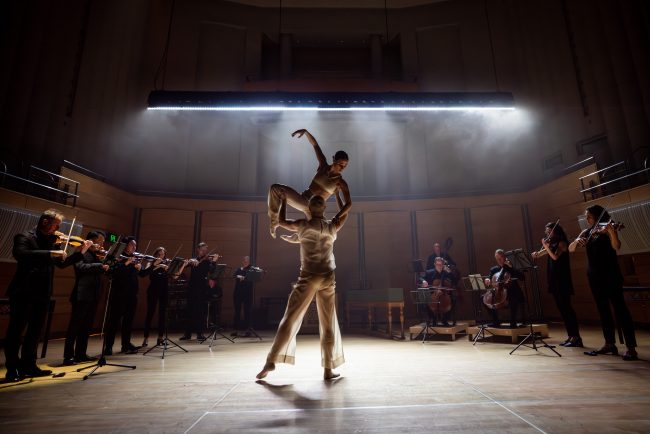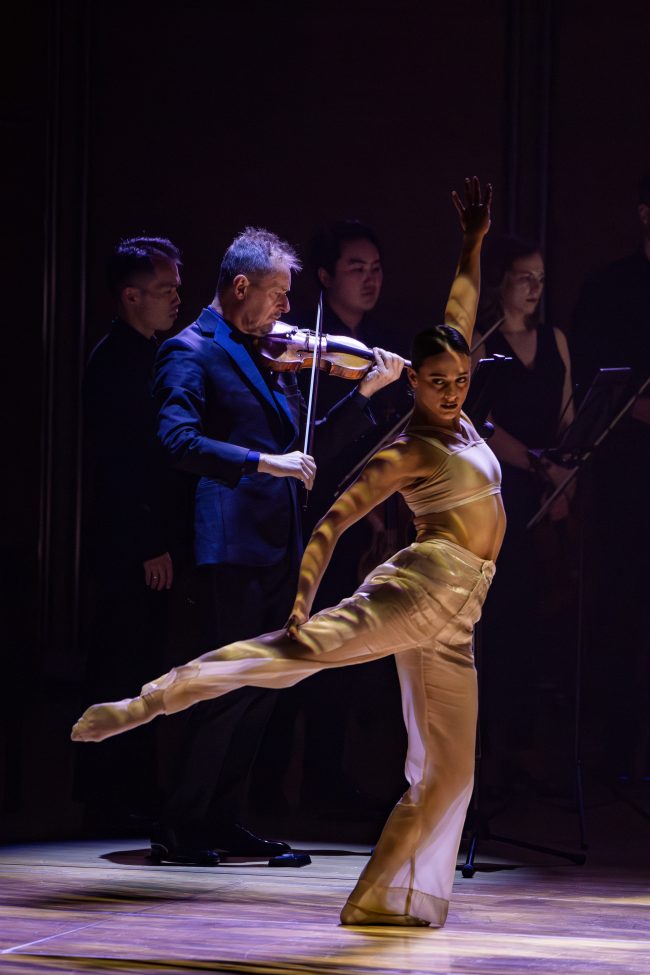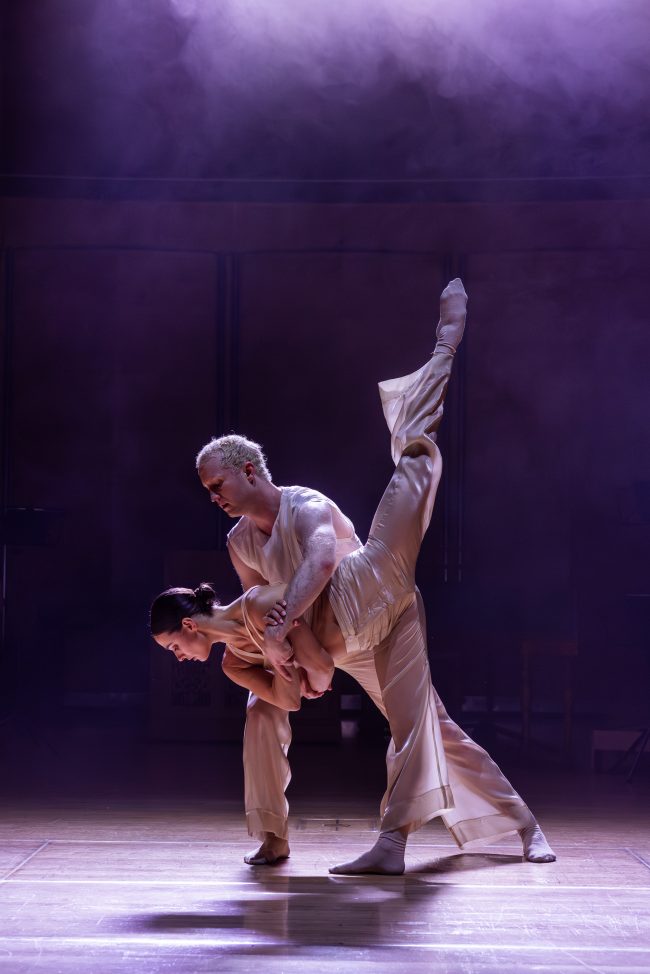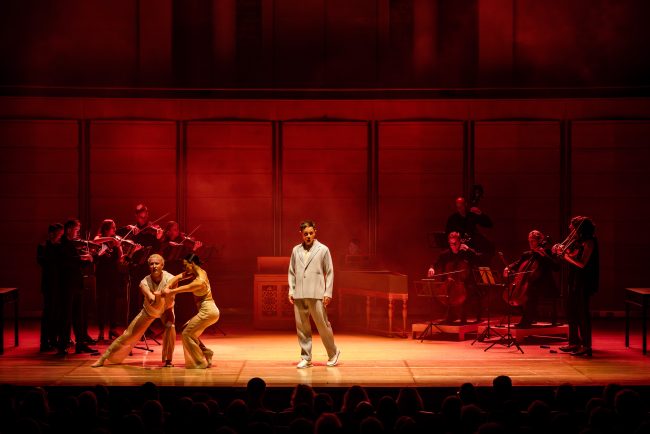
Saturday 3 August 2024
Australian Chamber Orchestra and Sydney Dance Company
Review by Paul Neeson (Arts Wednesday)

In Silence & Rapture the ACO combines the music of JS Bach and Arvo Pärt with contemporary dance choreographed by Sydney Dance Company’s Rafael Bonachela, and the question I am pondering is was it a successful marriage?
The lights were low and the smoke machine started well before the musicians arrived on stage, it set an ambient scene. Was it sacred or profane? Full of mystery and anticipation. One played with the idea that it’s a kind of devil’s hour, misty canals, Venice Carnevale where one might encounter the ice cold breath of a lustful vampire in the cold dead of night – such was the drama. But no, absolutely no, it was sacred from beginning to end – it was God’s gardens they were creating.
The prelude (as it was called in the program notes) comprised a short orchestral work by both Bach and Pärt to give us a taste of what was to come and adjust our ears to the musical soundworld we were about to enter. The separation of 300 years of compositional style was immediately apparent. Both are mathematically structured, JS Bach’s Kannon was lilting and mesmerising, and while Pärt’s Collage on B-A-C-H flowed seamlessly out of the Bach it soon became acerbic, dissonant and angular. This is the genius of the ACO’s programming tying seemingly disparate works together and leaving us to find the connection, leaving us in a kind of awe of just what is possible if one stretches some boundaries.
Next the two dancers, Emily Seymour and Liam Green as well as counter-tenor Iestyn Davies appeared onstage, their pale blue outfits contrasting to the severe black and white of the musicians. We were immediately struck by the power and clarity of Iestyn’s voice which is perfectly crafted for the Baroque repertoire.

The dancers, when they began to move were given the task of juxtaposing ultra modern choreography against music from a long past era: sharp, angular, rapid – tiny hand, leg and arm movements echoed the Baroque music on the surface, but we were left questioning whether it reflected or suited the timing inherent to the longer phrasing and implied structures in Bach’s music. Was this the intention? Again referring to the notes, this section of the program “Hope and Temptation: Garden of Eden” was about conflict between innocence and corruption at the end of the day.
Where the choreography and the music really came together was in the middle section “Tragedy and Passion: Garden of Gethsemane.” In the aria from St. Matthew Passion the depth of emotion was reflected in the dance movements which were slower, more rhythmically in tune with the music and, dare I say, more beautiful. Now the choreography utilised the dancers working in contact with each other in flowing steps, as opposed to sharp steps in opposition. This section really tugged on the heart strings, no more so than Arvo Pärt’s My Heart is in the Highlands, a very moving lament based on only three notes.
In the final section we have moved to the “Garden of Heaven” and it is time to be redeemed. The joy and rejoicing of Bach’s Solo Cello Suite 3 contrasting with the darkness of the minor key of his Solo Violin Sonata 2 in the previous section. The rejoicing and redemption reaching a conclusion with a final aria from his Magnificat BWV243.
Then we literally faded “Into the Silence” with Bach’s final uncompleted work The Art of Fugue, leaving the dancers to conclude (almost) our musical journey completely unaccompanied. The silence only broken by their footsteps onstage, slow flowing movements in the the pale blue light. Was it heavenly or cold after the red and orange glows that dominated the lighting design (Damien Cooper) up to this point? Again we are left to decide this things for ourselves.

As an artistic artefact, Silence & Rapture is complex and informed by a high degree of academic knowledge. The extensive program notes guided us through some of the more obscure detail of the program, such as the final work of the concert, Paul Hindemith’s Trauermusik, quoting the chorale the Bach’s son used to fill the silence on his father’s incomplete final composition. That level of musicology might even be beyond the knowledge of an ACO audience. Nonetheless the purity and technical brilliance of the art (was it art for art’s sake?) for a first viewing was more than enough. We were asked to hold our applause until the very end of the night, and when the lights faded to black we held our breaths absorbing the impact of what we had just witnessed. Then the house lights came up and only then we burst into to a rapturous response. We may have had varying levels of understanding but we knew what we had seen was both satisfying and enlightening beyond our expectations.
This program is worthy of a PhD thesis. The creators worked hard over weeks if not months (perhaps years) to devise the program – the last time the ACO worked with Sydney Dance Company was 10 years ago. With one viewing in real time it is, I dare say, impossible to grasp the depth and complexity of the work. Hopefully Silence & Rapture will gain a reputation sufficient for it to be included in the canon and we can garner new meanings each time we see and hear it.
You can listen to a recent interview with ACO Principal Cello, Tipi Valve below.